The Rearrangement of Alkylallenes to 1,3-Dienes
Abstract
:1. Introduction
2. Acid-Mediated Rearrangements
3. Thermal-Mediated Rearrangements
4. Transition-Metal-Promoted Rearrangements
4.1. Gold
4.2. Palladium
4.3. Iron
4.4. Nickel
5. Radical
6. Summary
Author Contributions
Funding
Institutional Review Board Statement
Informed Consent Statement
Acknowledgments
Conflicts of Interest
References
- Deagostino, A.; Prandi, C.; Zavattaro, C.; Venturello, P. Functionalized 1-Alkoxy-1,3-dienes: Their Preparation and Applications in Synthetic Organic Chemistry. Eur. J. Org. Chem. 2006, 2006, 2463–2483. [Google Scholar] [CrossRef]
- Nicolaou, K.C.; Snyder, S.A.; Montagnon, T.; Vassilikogiannakis, G. The Diels-Alder Reaction in Total Synthesis. Angew. Chem. Int. Ed. 2002, 41, 1668–1698. [Google Scholar] [CrossRef]
- Negishi, E.; Huang, Z.; Wang, G.; Mohan, S.; Wang, C.; Hattori, H. Recent Advances in Efficient and Selective Synthesis of Di-, Tri-, and Tetrasubstituted Alkenes via Pd-Catalyzed Alkenylation-Carbonyl Olefination Synergy. Acc. Chem. Res. 2008, 41, 1474–1485. [Google Scholar] [CrossRef] [PubMed]
- de Paolis, M.; Chataigner, I.; Maddaluno, J. Recent Advances in Stereoselective Synthesis of 1,3-dienes. In Stereoselective Alkene Synthesis. Topics in Current Chemistry; Wang, J., Ed.; Springer: Berlin/Heidleberg, Germany, 2012; Volume 327, pp. 87–146. [Google Scholar]
- Ghogare, A.A.; Greer, A. Using Singlet Oxygen to Synthesize Natural Products and Drugs. Chem. Rev. 2016, 116, 9994–10034. [Google Scholar] [CrossRef]
- Kobayashi, M.; Higuchi, K.; Murakami, N.; Tajima, H.; Aoki, S. Total synthesis of callystatin A, a potent cytotoxic polyketide from the marine sponge, Callyspongia truncata. Tetrahedron Lett. 1997, 38, 2859–2862. [Google Scholar] [CrossRef]
- Serhan, C.N. Pro-resolving lipid mediators are leads for resolution physiology. Nature 2014, 510, 92–101. [Google Scholar] [CrossRef] [Green Version]
- Kupchan, S.M.; Komoda, Y.; Court, W.A.; Thomas, G.J.; Smith, R.M.; Karim, A.; Gilmore, C.J.; Haltiwanger, R.C.; Bryan, R.F. Maytansine, a Novel Antileukemic Ansa Macrolide from Maytenus ovatus. J. Am. Chem. Soc. 1972, 94, 1354–1356. [Google Scholar] [CrossRef] [PubMed]
- Madden, K.S.; Mosa, F.A.; Whiting, A. Non-isoprenoid polyene natural products – structures and synthetic strategies. Org. Biomol. Chem. 2014, 12, 7877–7899. [Google Scholar] [CrossRef]
- Soengas, R.G.; Rodriguez-Solla, H. Modern Synthetic Methods for the Stereoselective Construction of 1,3-Dienes. Molecules 2021, 26, 249–289. [Google Scholar] [CrossRef]
- Maryanoff, B.E.; Reitz, A.B. The Wittig olefination reaction and modifications involving phosphoryl-stabilized carbanions. Stereochemistry, mechanism, and selected synthetic aspects. Chem. Rev. 1989, 89, 863–927. [Google Scholar] [CrossRef]
- Ager, D.J. Organic Reactions; John Wiley & Sons, Inc.: Hoboken, NJ, USA, 1990; pp. 1–223. [Google Scholar]
- Dong, D.-J.; Li, H.-H.; Tian, S.-K. A Highly Tunable Stereoselective Olefination of Semistabilized Triphenylphosphonium Ylides with N-Sulfonyl Imines. J. Am. Chem. Soc. 2010, 132, 5018–5020. [Google Scholar] [CrossRef] [PubMed]
- Borg, T.; Tuzina, P.; Somfai, P. Lewis Acid-Promoted Addition of 1,3-Bis(silyl)propenes to Aldehydes: A Route to 1,3-Dienes. J. Org. Chem. 2011, 76, 8070–8075. [Google Scholar] [CrossRef] [PubMed]
- Billard, F.; Robiette, R.; Pospíšil, J. Julia–Kocienski Reaction-Based 1,3-Diene Synthesis: Aldehyde-Dependent (E,E/E,Z)-Selectivity. J. Org. Chem. 2012, 77, 6358–6364. [Google Scholar] [CrossRef] [PubMed]
- Zhou, R.; Wang, C.; Song, H.; He, Z. Wittig Olefination between Phosphine, Aldehyde, and Allylic Carbonates: A General Method for Stereoselective Synthesis of Trisubstituted 1,3-Dienes with Highly Variable Substituents. Org. Lett. 2010, 12, 976–979. [Google Scholar] [CrossRef] [PubMed]
- Miyaura, N.; Suzuki, A. Palladium-Catalyzed Cross-Coupling Reactions of Organoboron Compounds. Chem. Rev. 1995, 95, 2457–2483. [Google Scholar] [CrossRef] [Green Version]
- Lemhadri, M.; Battace, A.; Berthiol, F.; Zair, T.; Doucet, H.; Santelli, M. Palladium-Tetraphosphine Complex Catalysed Heck Reaction of Vinyl Bromides with Alkenes: A Powerful Access to Conjugated Dienes. Synthesis 2008, 7, 1142–1152. [Google Scholar]
- Molander, G.A.; Felix, L.A. Stereoselective Suzuki−Miyaura Cross-Coupling Reactions of Potassium Alkenyltrifluoroborates with Alkenyl Bromides. J. Org. Chem. 2005, 70, 3950–3956. [Google Scholar] [CrossRef]
- Zheng, C.; Wang, D.; Stahl, S.S. Catalyst-Controlled Regioselectivity in the Synthesis of Branched Conjugated Dienes via Aerobic Oxidative Heck Reactions. J. Am. Chem. Soc. 2012, 134, 16496–16499. [Google Scholar] [CrossRef] [Green Version]
- Delcamp, J.H.; Gormisky, P.E.; White, M.C. Oxidative Heck Vinylation for the Synthesis of Complex Dienes and Polyenes. J. Am. Chem. Soc. 2013, 135, 8460–8463. [Google Scholar] [CrossRef] [Green Version]
- Diver, S.T.; Giessert, A.J. Enyne Metathesis (Enyne Bond Reorganization). Chem. Rev. 2004, 104, 1317–1382. [Google Scholar] [CrossRef]
- Zhang, L.; Sun, J.; Kozmin, S.A. Gold and Platinum Catalysis of Enyne Cycloisomerization. Adv. Synth. Catal. 2006, 348, 2271–2296. [Google Scholar] [CrossRef]
- Poulsen, C.S.; Madsen, R. Enyne Metathesis Catalyzed by Ruthenium Carbene Complexes. Synthesis 2003, 1, 1–18. [Google Scholar] [CrossRef]
- Trost, B.M.; Frederiksen, M.U.; Rudd, M.T. Ruthenium-Catalyzed Reactions—A Treasure Trove of Atom-Economic Transformations. Angew. Chem. Int. Ed. 2005, 44, 6630–6666. [Google Scholar] [CrossRef]
- Hayashi, R.; Hsung, R.P.; Feltenberger, J.B.; Lohse, A.G. Regio- and Stereoselective Isomerization of Allenamides: Synthesis of 2-Amido-Dienes and Their Tandem Isomerization-Electrocyclic Ring-Closure. Org. Lett. 2009, 11, 2125–2128. [Google Scholar] [CrossRef] [Green Version]
- Hayashi, R.; Feltenberger, J.B.; Lohse, A.G.; Walton, M.C.; Hsung, R.P. An efficient and practical entry to 2-amido-dienes and 3-amido-trienes from allenamides through stereoselective 1,3-hydrogen shifts. Beilstein J. Org. Chem. 2011, 7, 410–420. [Google Scholar] [CrossRef]
- Lu, T.; Lu, Z.; Ma, Z.-X.; Zhang, Y.; Hsung, R.P. Allenamides: A Powerful and Versatile Building Block in Organic Synthesis. Chem. Rev. 2013, 113, 4862–4904. [Google Scholar] [CrossRef] [Green Version]
- Trost, B.M.; Kazmaier, U. Internal redox catalyzed by triphenylphosphine. J. Am. Chem. Soc. 1992, 114, 7933–7935. [Google Scholar] [CrossRef]
- Hampton, C.S.; Harmata, M. Mechanistic Aspects of the Phosphine-Catalyzed Isomerization of Allenic Sulfones to 2-Arylsulfonyl 1,3-Dienes. J. Org. Chem. 2015, 80, 12151–12158. [Google Scholar] [CrossRef] [PubMed]
- Wang, Z.; Xu, X.; Kwon, O. Phosphine catalysis of allenes with electrophiles. Chem. Soc. Rev. 2014, 43, 2927–2940. [Google Scholar] [CrossRef] [PubMed] [Green Version]
- Hampton, C.S.; Harmata, M. Mechanistic Aspects of the Palladium-Catalyzed Isomerization of Allenic Sulfones to 1-Arylsulfonyl 1,3-Dienes. J. Org. Chem. 2016, 81, 4807–4822. [Google Scholar] [CrossRef] [PubMed]
- Tsuboi, S.; Masuda, T.; Takeda, A. Highly stereocontrolled synthesis of (2E,4Z)-dienoic esters with alumina catalyst. Its application to total syntheses of flavor components and insect pheromones. J. Org. Chem. 1982, 47, 4478–4482. [Google Scholar] [CrossRef]
- Amos, R.A.; Katzenellenbogen, J.A. Reaction of copper enolates of esters with propargylic systems. Facile preparation of 3,4-dienoic esters, stereoselective rearrangement to (2E,4Z)- and (2E,4E)-dienoic esters, and stereoselective synthesis of a fragrance from the Bartlett pear. J. Org. Chem. 1978, 43, 555–560. [Google Scholar] [CrossRef]
- Hendrick, C.A.; Willy, W.E.; McKean, D.R.; Baggiolini, E.; Siddall, J.B. Approaches to the synthesis of the insect juvenile hormone analog ethyl 3,7,11-trimethyl-2,4-dodecadienoate and its photochemistry. J. Org. Chem. 1975, 40, 8–15. [Google Scholar] [CrossRef]
- Alcaide, B.; Almendros, P.; Aragoncilli, C.; Redondo, M.C. Stereoselective Synthesis of 1,2,3-Trisubstituted 1,3-Dienes through Novel [3,3]-Sigmatropic Rearrangements in α-Allenic Methanesulfonates: Application to the Preparation of Fused Tricyclic Systems by Tandem Rearrangement/Diels-Alder Reaction. Eur. J. Org. Chem. 2005, 1, 98–106. [Google Scholar] [CrossRef]
- Matsumoto, K.; Mizushina, N.; Yoshida, M.; Shindo, M. Stereocontrolled Synthesis of Multisubstituted 1,3-dienes via an Allene-Claisen Rearrangement. Synlett 2017, 28, 2340–2344. [Google Scholar] [CrossRef] [Green Version]
- Krafft, M.E.; Hallal, K.M.; Vidhani, D.V.; Cran, J.W. Gold(I)-catalysed Claisen rearrangement of allenyl vinyl ethers; synthesis of substituted 1,3-dienes. Org. Biomol. Chem. 2011, 9, 7535–7538. [Google Scholar] [CrossRef] [PubMed]
- Deng, Y.; Jin, X.; Fu, C.; Ma, S. Efficient Highly Selective Synthesis of Methyl 2-(Ethynyl)alk-2-(E)-enoates and 2-(1’-Chlorovinyl)alk-2(Z)-enoates from 2-(Methoxycarbonyl)2,3-allenols. Org. Lett. 2009, 11, 2169–2172. [Google Scholar] [CrossRef] [PubMed]
- Deng, Y.; Jin, X.; Ma, S. Studies on Highly Stereoselective Addition-Elimination Reactions of 3-(Methoxycarbonyl)-1,2-allen-4-ols with MX. An Efficient Synethsis of 3-(Methoxycarbonyl)-2-1,3(Z)-dienes. J. Org. Chem. 2007, 72, 5901–5904. [Google Scholar] [CrossRef]
- Horvárth, A.; Backväll, J.E. Palladium(II)-Catalyzed SN2’ Reactions of α-Allenic Acetates. Stereoconvergent Synthesis of (Z,E)-2-Bromo-1,3-dienes. J. Org. Chem. 2001, 66, 8120. [Google Scholar] [CrossRef] [PubMed]
- Zhang, X.; Fu, C.; Ma, S. Highly Stereoselective Facile Synthesis of 2-Acetoxy-1,3(E)-alkadienes via Rh(I)-Catalyzed Isomerization of 2,3-Allenyl Carboxylates. Org. Lett. 2011, 13, 1920–1923. [Google Scholar] [CrossRef]
- Buzas, A.K.; Istrate, F.M.; Gagosz, F. Gold(I)-Catalyzed Isomerization of Allenyl Carbinol Esters: An Efficient Access to Functionalized 1,3-Butadien-2-ol Esters. Org. Lett. 2007, 9, 985. [Google Scholar] [CrossRef] [PubMed]
- Wang, S.; Zhang, L. Gold-Catalyzed Efficient Formation of Alkenyl Enol Esters/Carbonates from Trimethylsilylmethyl-Substituted Propargyl Esters/Carbonates. Org. Lett. 2006, 8, 4585–4587. [Google Scholar] [CrossRef] [PubMed]
- Yu, S.; Ma, S. Allenes in Catalytic Asymmetric Synthesis and Natural Product Syntheses. Angew. Chem. Int. Ed. 2012, 51, 3074–3112. [Google Scholar] [CrossRef] [PubMed]
- Neff, R.K.; Frantz, D.E. Recent Advances in the Catalytic Syntheses of Allenes: A Critical Assessment. ACS Catal. 2014, 4, 519–528. [Google Scholar] [CrossRef]
- Jacobs, T.L.; Johnson, R.N. The Addition of Hydrogen Chloride to Aliphatic Allenic Hydrocarbons. J. Am. Chem. Soc. 1960, 82, 6397–6404. [Google Scholar] [CrossRef]
- Wenkert, E.; Leftin, M.H.; Michelotti, E.L. Synthesis of Allenes by Nickel-Catalyzed Grignard Reactions with Silylpropargyl Alcohols. J. Org. Chem. 1985, 50, 1122–1124. [Google Scholar] [CrossRef]
- Kropp, P.J.; Breton, G.W.; Craig, S.L.; Crawford, S.D.; Durland, W.F.; Jones, J.E.; Raleigh, J.S. Surface-Mediated Reactions. 6. Effects of Silica Gel and Alumina on Acid-Catalyzed Reactions. J. Org. Chem. 1995, 60, 4146–4152. [Google Scholar] [CrossRef]
- Li, W.; Shi, M.; Li, Y. Brønsted Acid Mediated Novel Rearrangements of Diarylvinylidenecyclopropanes and Mechanistic Investigations Based on DFT Calculations. Chem. Eur. J. 2009, 15, 8852–8860. [Google Scholar] [CrossRef]
- Sanz, R.; Miguel, D.; Martínez, A.; Gohain, M.; García-García, P.; Fernández-Rodríguez, M.A.; Álvarez, E.; Rodríguez, F. Brønsted Acid Catalyzed Alkylation of Indoles with Tertiary Propargylic Alcohols: Scope and Limitations. Eur. J. Org. Chem. 2010, 36, 7027–7039. [Google Scholar] [CrossRef] [Green Version]
- Titov, A.A.; Kobzev, M.S.; Borisova, T.N.; Listratova, A.V.; Evenko, T.V.; Varlamov, A.V.; Voskressensky, L.G. Facile Methods for the Synthesis of 8-Ylidene-1,2,3,8-tetrahydrobenzazecines. Eur. J. Org. Chem. 2020, 20, 3041–3049. [Google Scholar] [CrossRef]
- Crandall, J.K.; Paulson, D.R. The Pyrolysis of Alkenylidenecyclopropanes. A Convenient Synthesis of Dimethylenecyclopropanes. J. Am. Chem. Soc. 1966, 88, 4302–4303. [Google Scholar] [CrossRef]
- Bloch, R.; le Perchec, P.; Conia, J.-M. Dimethylenecyclopropane. Angew. Chem. Int. Ed. Engl. 1970, 9, 798–799. [Google Scholar] [CrossRef]
- Jones, M.; Hendrick, M.E.; Hardie, J.A. Pyrolysis of Phenylalkenylidenecyclopropanes. J. Org. Chem. 1971, 36, 3061–3062. [Google Scholar] [CrossRef]
- Taylor, D.R.; Wright, D.B. Thermal Cycloadditions and Isomerisation of Tetramethylallene. Chem. Commun. 1968, 8, 434–435. [Google Scholar] [CrossRef]
- Meier, H.; Schmitt, M. Cycloalkin-vinylidnencycloalkan-Umlagerungen. Tetrahedron Lett. 1989, 30, 5873–5876. [Google Scholar] [CrossRef]
- Jensen, F. A Theoretical Study of the Allene Effect in [1,n] Sigmatropic Hydrogen Shifts. J. Am. Chem. Soc. 1995, 117, 7487–7492. [Google Scholar] [CrossRef]
- Krause, N.; Winter, C. Gold-Catalyzed Nucleophilic Cyclization of Functionalized Allenes: A Powerful Access to Carbo- and Heterocycles. Chem. Rev. 2011, 111, 1994–2009. [Google Scholar] [CrossRef] [PubMed]
- Ting, C.-M.; Hsu, Y.-L.; Liu, R.-S. Gold-catalysed isomerisation of unactivated allenes into 1,3-dienes under ambient conditions. Chem. Commun. 2012, 48, 6577–6579. [Google Scholar] [CrossRef]
- Chen, J.-M.; Chang, C.-J.; Ke, Y.-J.; Liu, R.-S. Catalytic Formal [4+2] Cycloadditions between Unactivated Allenes and N-Hydroxyaniline Catalyzed by AlCl3/CuCl2/O2. J. Org. Chem. 2014, 79, 4306–4311. [Google Scholar] [CrossRef] [PubMed]
- Brown, J.; Robertson, B.D.; Widenhoefer, R.A. Synthesis and X-ray crystal structure of a cationic gold (I) π-(1,3-diene) complex generated via isomerization of a gold π-allene complex. J. Organomet. Chem. 2014, 758, 25–28. [Google Scholar] [CrossRef]
- Basak, A.; Chakrabarty, K.; Ghosh, A.; Das, G.K. Mechanism of the Gold(III)-Catalyzed Isomerization of Substituted Allenes to Conjugated Dienes: A DFT Study. J. Org. Chem. 2013, 78, 9715–9724. [Google Scholar] [CrossRef]
- Lechel, T.; Pfrengle, F.; Reissig, H.-U.; Zimmer, R. Three Carbons for Complexity! Recent Developments of Palladium-Catalyzed Reactions of Allenes. ChemCatChem. 2013, 5, 2100–2130. [Google Scholar] [CrossRef]
- Shimizu, I.; Tsuji, J. Palladium-Catalyzed Synthesis of 2,3-Disubstituted Allylamines by Regioselective Aminophenylation or Aminoalkenylation of 1,2-Dienes. Chem. Lett. 1984, 13, 233–236. [Google Scholar] [CrossRef]
- Shimizu, I.; Sugiura, T.; Tsuji, J. Facile Synthesis of β-Aryl- or β-Alkenyl-β-methyl-α,β-unsaturated Carbonyl Compounds by Palladium-Catalyzed Reaction of 1,2-Dien-4-ols with Aryl or Alkenyl Halides. J. Org. Chem. 1985, 50, 537–539. [Google Scholar] [CrossRef]
- Al-Masum, M.; Yamamoto, Y. Palladium-Catalyzed Hydrocarboxylation of Allenes. J. Am. Chem. Soc. 1998, 120, 3809–3810. [Google Scholar] [CrossRef]
- Al-Jawaheri, Y.; Turner, M.; Kimber, M.C. Enabling the Rearrangement of Unactivated Allenes to 1,3-Dienes by Used of a Palladium (0) / Boric acid System. Synthesis 2018, 50, 2329–2336. [Google Scholar]
- Al-Jawaheri, Y.; Kimber, M.C. Synthesis of 1,3-Dienes via a Sequential Suzuki-Miyaura Coupling/Palladium-Mediated Allene Isomerization Sequence. Org. Lett. 2016, 18, 3502–3505. [Google Scholar] [CrossRef] [PubMed] [Green Version]
- Vine, L.E.; Schomaker, J.M. Pd-Catalyzed Heck-Type Reactions of Allenes for Stereoselective Synthesis of Substituted 1,3-Dienes. Chem. Eur. J. 2021. [Google Scholar] [CrossRef]
- Ben-Shoshan, R.; Pettit, R. A Novel Type of Valence Tautomerism in Organometallic Complexes. J. Am. Chem. Soc. 1967, 89, 2231–2232. [Google Scholar] [CrossRef]
- Arai, S.; Hori, H.; Amako, Y.; Nishida, A. A new protocol for nickel-catalysed regio- and stereoselective hydrocyanation of allenes. Chem. Commun. 2015, 51, 7493–7496. [Google Scholar] [CrossRef] [PubMed]
- Amako, Y.; Arai, S.; Nishida, A. Transfer of axial chirality through the nickel-catalysed hydrocyanation of chiral allenes. Org. Biomol. Chem. 2017, 15, 1612–1617. [Google Scholar] [CrossRef] [PubMed]
- Jones, N.R.; Pattenden, G. Alkene-allenecyclopropane radical cyclisations promooted by tris-(trimethylsilyl)silane. Tetrahedron Lett. 2009, 50, 3527–3529. [Google Scholar] [CrossRef]
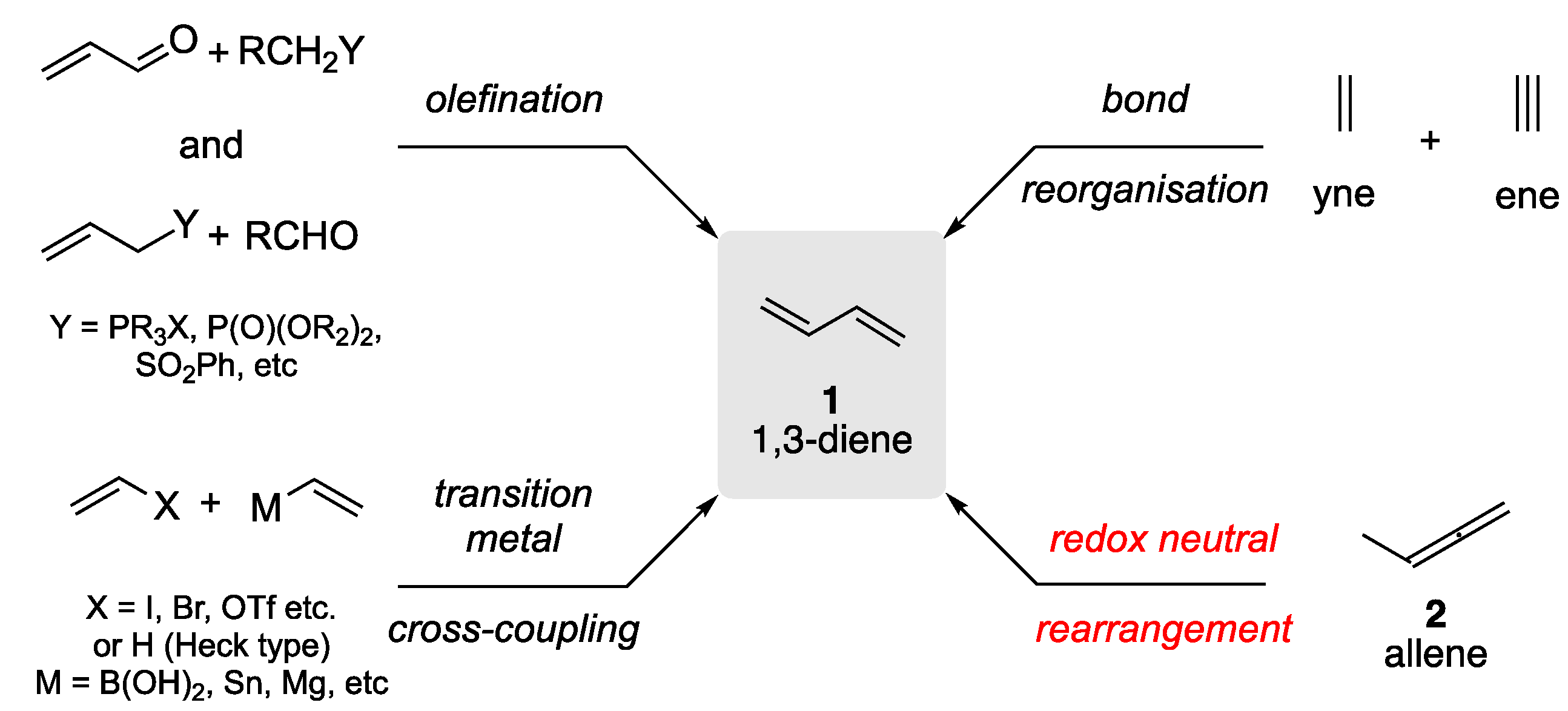



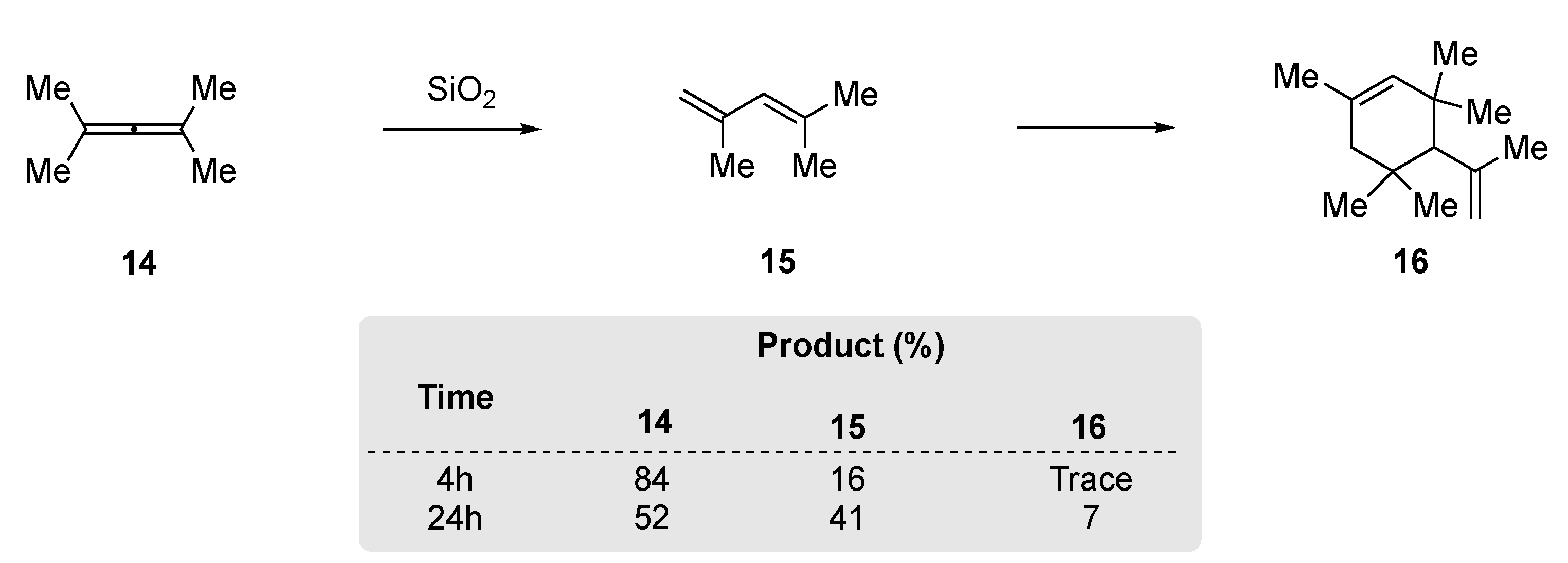







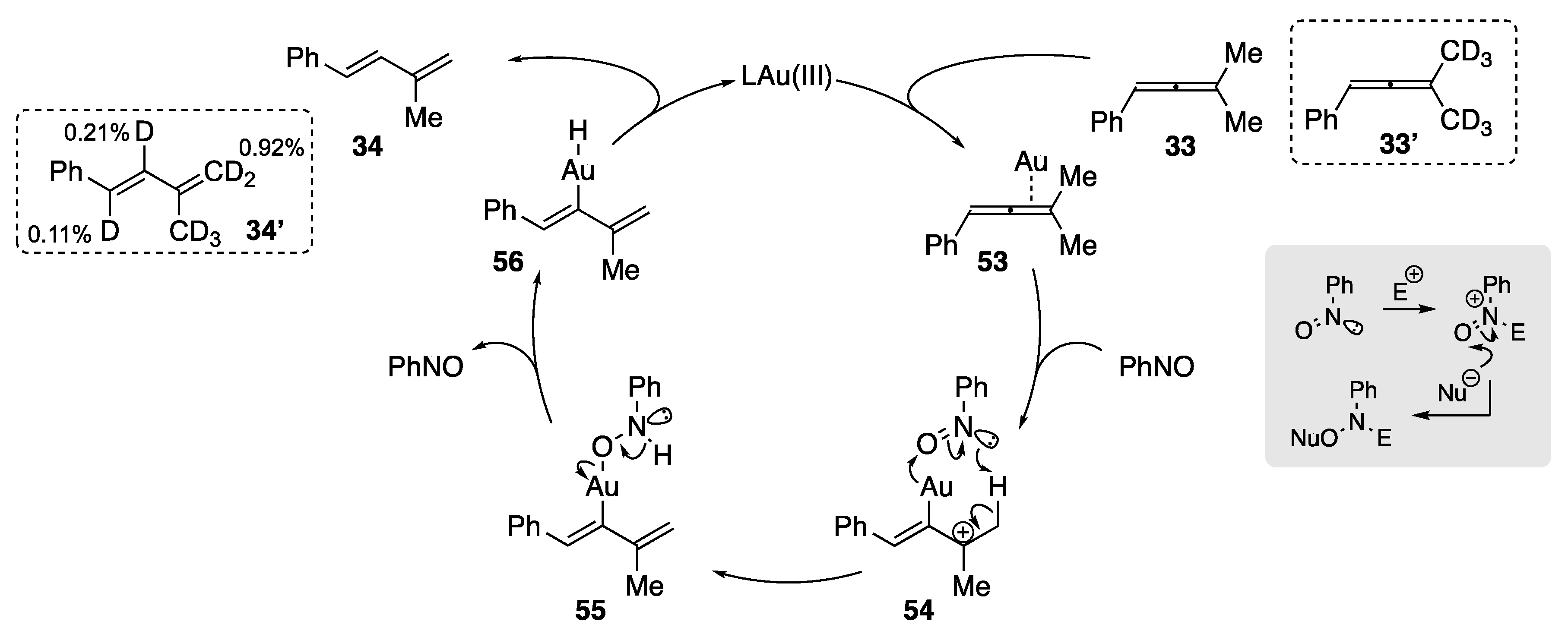
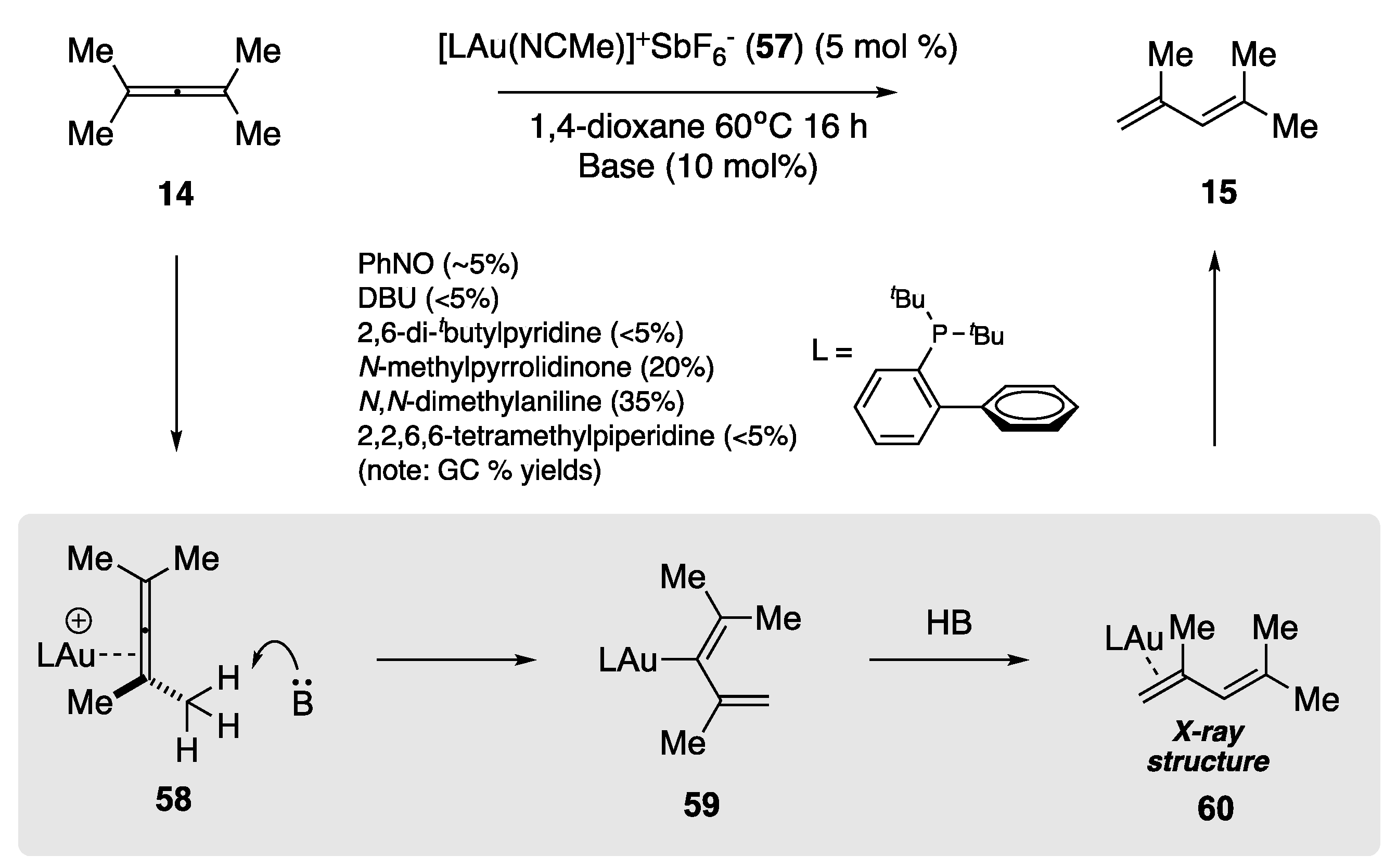
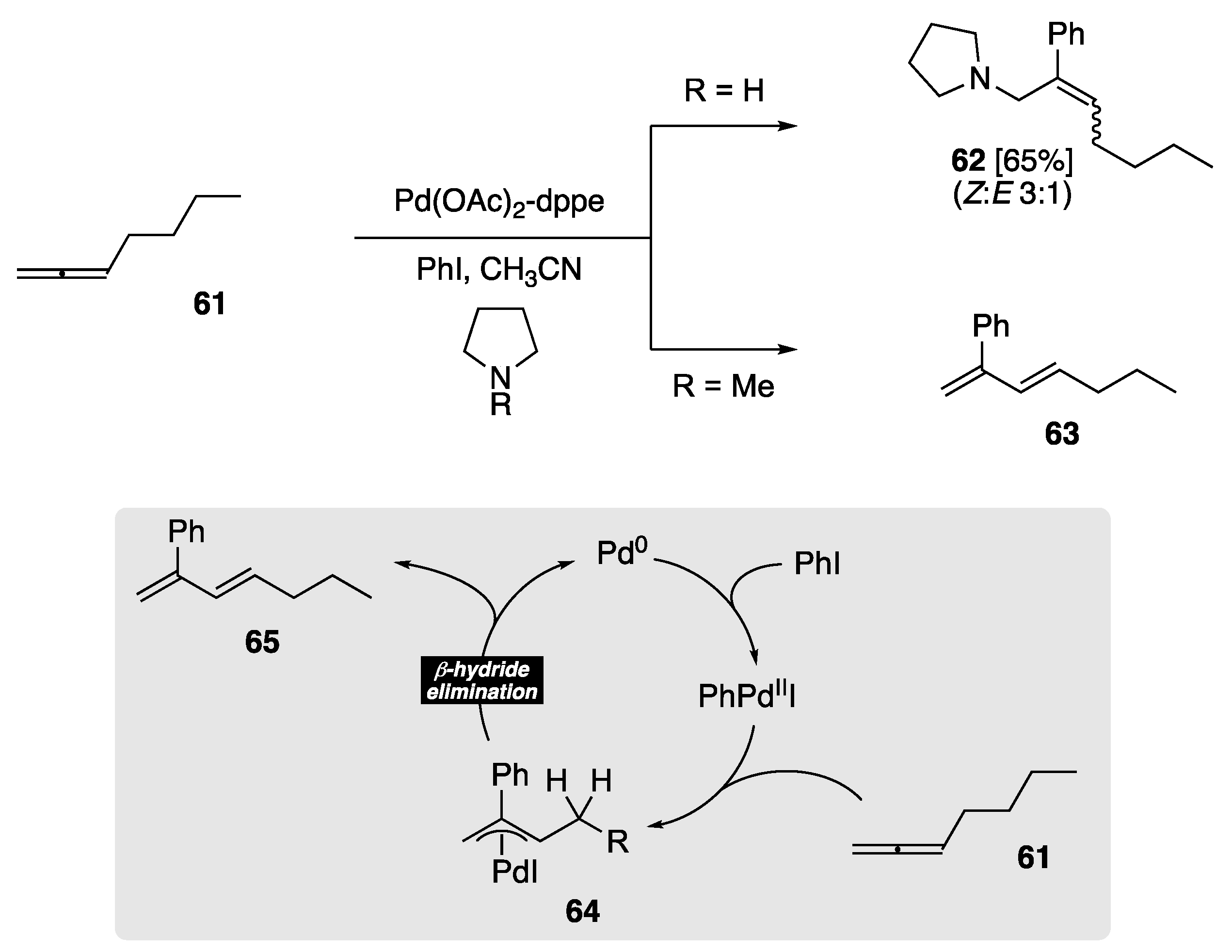


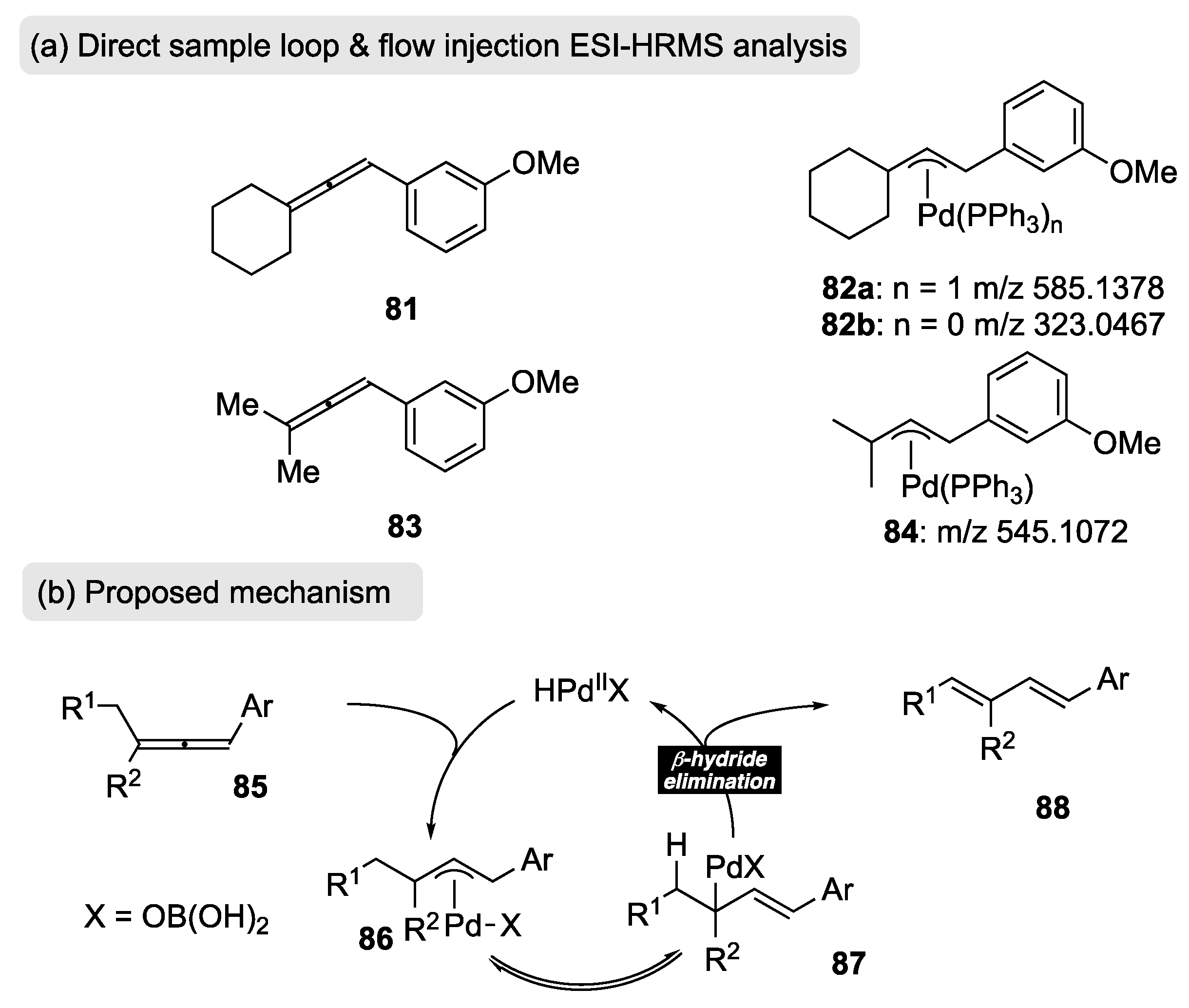




Publisher’s Note: MDPI stays neutral with regard to jurisdictional claims in published maps and institutional affiliations. |
© 2022 by the authors. Licensee MDPI, Basel, Switzerland. This article is an open access article distributed under the terms and conditions of the Creative Commons Attribution (CC BY) license (https://creativecommons.org/licenses/by/4.0/).
Share and Cite
Al-Jawaheri, Y.; Kimber, M.C. The Rearrangement of Alkylallenes to 1,3-Dienes. Reactions 2022, 3, 70-86. https://doi.org/10.3390/reactions3010006
Al-Jawaheri Y, Kimber MC. The Rearrangement of Alkylallenes to 1,3-Dienes. Reactions. 2022; 3(1):70-86. https://doi.org/10.3390/reactions3010006
Chicago/Turabian StyleAl-Jawaheri, Yassir, and Marc Colin Kimber. 2022. "The Rearrangement of Alkylallenes to 1,3-Dienes" Reactions 3, no. 1: 70-86. https://doi.org/10.3390/reactions3010006






